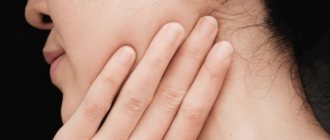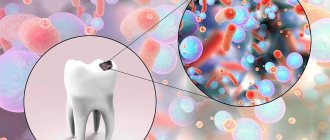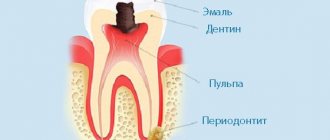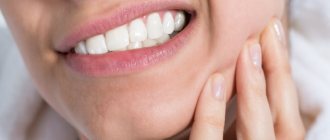Pain in the throat and ear is a clinical manifestation of a number of otolaryngological diseases, and much less often - neoplasms of a malignant nature. Most often it is one-sided and signals the presence of inflammatory processes occurring in the sinuses, tonsils, lymph nodes and larynx. Treatment of chronic sore throat is aimed at eliminating inflammatory processes and pain symptoms. For this, the otolaryngologist prescribes medications.
The otolaryngology department of CELT offers diagnosis and treatment of chronic ear pain. Our multidisciplinary clinic has been operating in the paid medical services market in Moscow for almost thirty years. Our specialists operate with international treatment standards and have everything necessary for accurate diagnosis and effective treatment in accordance with them.
At CELT you can consult an otorhinolaryngologist.
- Initial consultation – 3,000
- Repeated consultation – 2,000
Make an appointment
Symptoms of acute tracheitis
Acute tracheitis is manifested primarily by attacks of coughing - dry, painful, quite rough and intrusive. It intensifies at night and in the morning, which is associated with the accumulation of sputum in the respiratory tract. A coughing attack during tracheitis can also be provoked by other factors: laughter, screaming, deep breaths, contrasting air temperature, strong aromas and smoke. In the first days, sputum is hardly formed or remains so viscous that it is difficult to pass away. Therefore, at the beginning of the disease, the cough is dry, annoying, and does not bring relief. As tracheitis develops and when the bronchi are involved in the inflammatory process, sputum production increases and it becomes thinner. At the same time, the cough becomes moist, more productive and less exhausting, and its attacks are repeated less frequently. The patient's well-being improves significantly.
In addition to cough, other symptoms of acute tracheitis are often observed:
- pain, a feeling of rawness and burning behind the sternum, especially pronounced after another coughing attack;
- changes in the frequency and depth of breathing;
- increased body temperature (usually up to 38°C), which is typical mainly for infectious and complicated tracheitis;
- headache;
- general weakness, fatigue, fatigue and other signs of general intoxication.
It is important to know!
The inflammatory process with tracheitis often spreads to neighboring areas of the respiratory system, because there is no clear boundary between them, the mucous membrane smoothly passes from one part of the respiratory tract to another. The drainage of sputum or its upward movement when coughing contributes to tissue irritation and the spread of the pathogen. When the bronchi are involved in inflammation, tracheobronchitis develops. This is accompanied by a deterioration in the patient’s condition: his body temperature rises, coughing attacks become more frequent, chest pain becomes stronger, shortness of breath may appear. If tracheitis is accompanied by laryngitis, you need to be prepared for hoarseness or even temporary loss of voice. And with accompanying swelling of the subglottic space of the larynx (it is located approximately under the vocal cords), acute respiratory failure may develop with difficulty inhaling and a feeling of fear.
Common diseases that cause pain in the throat and ear
| Pathology | What is it characterized by? |
| Diphtheria | An acute infectious disease that develops as a result of exposure to bacterial agents. It is manifested by the development of fibrinous inflammatory processes in the area where the latter is introduced. Most often these are the upper respiratory tract, bronchi or oropharyngeal mucosa. |
| Measles | An acute infectious viral disease, manifested by the appearance of a rash on the skin, fever and pain in the throat, radiating to the ear. Its complication is often otitis media, which also causes pain. |
| Scarlet fever | Acute infectious processes that begin with a sore throat and are characterized by primary damage to the oropharynx, as well as pronounced intoxication. |
Why does acute tracheitis occur?
Infection
The development of the disease is most often caused by viral infections - influenza and other viruses that affect the respiratory tract and respiratory system. Bacteria can also be causative agents: pneumo-, strepto-, staphylococci and others. Often there is a so-called mixed infection, when inflammation is caused by several different pathogens at once. In this case, most often the bacterial infection is secondary; it complicates the course of ARVI.
Non-infectious factors
Acute tracheitis in an adult can also be non-infectious in nature, although this is less common.
- Mechanical injuries
. Traumatic tracheitis is possible when foreign bodies enter the respiratory tract, for example, as a result of insufficiently careful endoscopic examination of the bronchial system and tracheal intubation during surgical anesthesia.
- Thermal effects - inhalation of cold or (less often) very dry hot air
. In this case, the key point in the development of inflammation is not irritation of the walls of the trachea, but the vascular spasm that occurs in them. This leads to disruption of the functioning of the glands in the walls of the trachea and a decrease in the protective function of its mucous membrane.
- Chemical burns that occur when inhaling fumes from alkaline or acidic products
. These can be aggressive household chemicals, industrial waste, paint and varnish products, petroleum products, chemical reagents. This type of tracheitis is especially difficult.
- Irritation of the mucous membrane of the respiratory tract by polluted, dusty or excessively dry air
. Tobacco smoke, including passive smoking, is of particular importance.
- An allergic reaction in response to the entry of individually significant allergens into the respiratory tract
. In this case, tracheitis is usually combined with laryngitis, obstructive bronchitis (complete obstruction of the bronchial tubes) or even pulmonary edema.
Sometimes tracheitis becomes an occupational disease, that is, its occurrence is associated with harmful factors at work. Therefore, workers in hot shops, farms, chemical and oil refineries, as well as miners and stonemasons are at risk.
What contributes to the development of tracheitis?
Tracheitis does not develop in all people who have an acute respiratory viral infection, have been in contact with irritating substances, or have been frozen. The risk of tracheal damage increases in the presence of predisposing factors. First of all, these are any background diseases of the upper respiratory tract, accompanied by impaired nasal breathing. A runny nose of any nature, sinusitis, severe curvature of the nasal septum lead to the fact that a person begins to breathe through the mouth. As a result, insufficiently warmed and humidified air enters the larynx and trachea, which irritates the mucous membrane and increases the risk of inflammation during infection. Predisposing factors include heart disease, accompanied by chronic heart failure with stagnation in the pulmonary circulation. The resulting swelling of the mucous membrane leads to a decrease in its barrier function. Lack of vitamins and nutrients, decreased immunity, excess toxins in the body - all this also increases the risk of inflammation of the trachea in response to the introduction of a pathogen or hypothermia.
Causes of pain
Can the ear hurt for no reason due to cervical osteochondrosis? Medical experts answer this question in the negative. There is always some kind of trigger - an impetus that provoked the occurrence of an unpleasant symptom.
Unhealthy diet
Do not be surprised if pain in the ear area appeared due to the fact that you neglected the advice of your doctor and ate generally unhealthy foods. Neurologists
It’s not for nothing that they give their patients recommendations on proper nutrition - it is the main regulator of our well-being. If you experience ear pain due to osteochondrosis of the cervical spine, first of all, review your diet. Let the percentage of fresh vegetables and fruits, cereals and legumes, and clean drinking water increase.
Excessive fullness
Overweight patients may develop a large number of diseases associated with excess fat tissue in their body over time. This is due to metabolic disorders and, as a consequence, malfunctions of various organs. In this case, dietary nutrition and moderate physical activity will come to the rescue, which will help eliminate extra pounds and normalize well-being.
Sedentary and unhealthy lifestyle
Even the absence of excess weight is not a reason to give up physical education or sports. Ear pain due to osteochondrosis of the cervical spine is sometimes diagnosed in slender people who, to the detriment of their health, spend a large amount of time in front of a computer screen. Try to go to the gym, run in the morning, swim in the pool, and if you really don’t have enough time, at least walk one stop home at the end of the working day. Smoking and alcohol abuse not only cause worsening of osteochondrosis, but also other, much more severe and difficult to treat conditions. Doctors recommend that smokers gradually reduce the number of cigarettes they smoke during the day and try to compensate for the bad habit with the previously mentioned physical exercises. Also reconsider your attitude towards drinking alcoholic beverages; you should not get carried away with drinking them during the week. If it’s completely difficult to give up alcohol, then allow yourself no more than 1-2 glasses of really good wine on your day off.
Hypothermia
Ear pain that occurs with osteochondrosis of the cervical spine can be caused by simple hypothermia of the head. In this case, congestion or noise in the ears is often also observed, and the sensations are extremely unpleasant (shooting in the ear, as people say). Getting rid of the symptoms is quite simple - in case of intense pain, you can take paracetamol or ibuprofen, and drip an aqueous solution of furatsilin into the ear, pre-heated to a comfortable temperature. A visit to the doctor is a must!
Neck injuries
Fractures, cracks in bones and joints, damage to the soft tissues of the neck as a result of bruises or muscle sprains explain the fact that your ear begins to hurt from cervical osteochondrosis. If you suspect an injury, you should definitely see a surgeon
, who will give directions for x-rays and prescribe appropriate therapy.
Age-related changes
Over time, all metabolic processes in the body gradually slow down, a person begins to experience various types of ailments - this is a normal physiological process. The leaching of calcium from bones, as well as collagen and elastin from muscles, leads to various types of pathologies. An elderly patient may complain of hearing loss (decreased hearing), a condition in which there is a blockage in the ear, etc.
Treatment of acute tracheitis
Acute tracheitis must be treated under the supervision of a specialist. In some cases, additional examination is required to clarify the cause and nature of the disease.
The main objectives are:
- impact on the cause of the disease. This includes stopping an allergic reaction, eliminating an infection, removing a foreign body, avoiding the action of provoking factors;
- relief of coughing, transformation of a dry cough into a wet one;
- reducing the severity of inflammation;
- elimination of background and aggravating conditions of tracheitis: lack of vitamins, exhaustion, weakened immunity;
- reducing the severity of intoxication and (if necessary) lowering body temperature. It is important to remember that fever is a natural mechanism to fight infection. Therefore, you should not abuse antipyretics. They can improve your well-being, but do not affect the course of the disease.
Uncomplicated forms of tracheitis can be treated on an outpatient basis. But severe cases of the disease may require hospitalization. Particular attention is paid to the treatment of weakened and elderly patients, especially if they are unable to move independently for health reasons, because tracheitis in them quite easily turns into tracheobronchitis and even pneumonia. Treatment is carried out comprehensively, using medications and non-drug methods. You should not interrupt therapy after the condition improves; you must follow the time limits for taking medications recommended by your doctor.
Drug treatment of tracheitis
The drug treatment regimen for acute tracheitis is drawn up taking into account the nature of the disease and the severity of the patient’s symptoms.
Impact on the cause
If the causative agent is a particular virus, antiviral agents are usually used, as well as immunostimulants (for example, preparations based on echinacea). For severe and protracted tracheitis of a bacterial nature, the doctor may introduce antibiotics into the treatment regimen. If the disease proceeds without complications, it is usually possible to cope with it without these remedies. But the decision on the rationality and duration of antibiotic therapy should be made only by a doctor. In some cases, with tracheitis, a bacteriological examination of sputum is carried out before starting treatment with antimicrobial agents. It is sown on nutrient media to determine the type of pathogen and its sensitivity to the main groups of drugs. This will help you choose the most suitable antibiotic.
Treating coughs and clearing the airways
When treating acute tracheitis, great attention should be paid, of course, to cough, the main symptom of the disease. For a dry, debilitating, nonproductive cough, medications that suppress the cough reflex are used. This measure may be necessary in the first days of tracheitis. At the next stage of the disease, the main goal of treatment is to clear the airways of the mucus that forms. To do this, it is necessary to facilitate its passage with the help of mucolytic and expectorant agents. But they cannot be used simultaneously with antitussive drugs. It is also unacceptable to suppress a wet cough. This is fraught with stagnation of sputum and the transition of inflammation to the underlying parts of the respiratory system, up to the development of bronchopneumonia.
Maintenance therapy
Herbal remedies may be helpful to relieve the symptoms of tracheitis. For tracheitis, they can be used in the form of decoctions and infusions. But a more convenient and reliable method of treatment is the use of ready-made herbal products with a carefully selected and balanced composition. For example, in a complex treatment regimen for tracheitis, you can include Doctor MOM® cough syrup, which contains extracts of licorice, elecampane, Vasiki adatodes, Indian nightshade and other medicinal plants - 10 medicinal plants in total. It is suitable for both adults and children over 3 years old. This remedy helps thin mucus and helps remove it from the respiratory tract, and also relieves inflammation. For adults, there are also herbal cough lozenges Doctor MOM® based on extracts of licorice, ginger and Emblica officinalis. They also soften coughs and have anti-inflammatory and expectorant effects. Such lozenges can be used as an aid in the treatment of tracheitis. They help cope with coughing attacks and ease the course of the disease.
Treatment of sore throat and ear
To relieve a patient of a sore throat, it is necessary to accurately determine the cause that provokes it. CELT specialists conduct comprehensive diagnostic studies that eliminate the risk of error. For this, the patient is prescribed to undergo general laboratory tests, bacterial culture, X-ray and pharyngoscopy. Treatment tactics are developed based on the results obtained and the patient’s individual indications.
| Pathology | Treatment |
| Lymphadenitis | The acute form is treated conservatively: taking antibiotics and vitamins, as well as UHF. The purulent process is opened and drained. The chronic form requires elimination of the underlying disease, which provokes inflammatory processes in the lymph nodes and pain. |
| Rhinitis | The acute form is treated with medications, heat treatments and antibiotics if a bacterial agent is identified. As for chronic, it requires the use of astringents, antibacterial ointments, instillation of antiseptics and UHF. According to indications, cauterization of the nasal mucosa or cryodestruction is performed. |
| Sinusitis | Treatment is aimed at eliminating the inflammatory process and ensuring the outflow of purulent masses from the paranasal sinuses. The latter allows you to eliminate pain. The patient is prescribed antibacterial or antiviral drugs, and a maxillary sinusotomy is performed according to indications. |
| Tonsillitis | Treatment tactics are selected depending on the form and stage of the disease and provide an integrated approach. In the process, local procedures and drug treatment with the use of immunostimulants and immunocorrectors are used, which reduces pain and improves the general condition of the patient. Surgical treatment is aimed at removing the tonsils and is carried out according to indications if lymphoid tissue has been replaced by connective tissue. |
| Otitis | Treatment depends on which part of the hearing organ is affected. It is possible to use antiseptics that are injected into the ear canal. In addition, warm compresses, physiotherapeutic procedures, and the use of topical anti-inflammatory drugs are recommended. If the above does not give the desired result, the eardrum is pierced to ensure the drainage of pus. This automatically reduces pain and the patient feels relief. |
| Pharyngitis | It is important to eliminate the factors that provoke the disease. The patient should avoid consuming foods that can cause irritation to the mucous membrane. If a bacterial agent is detected, antibiotic therapy is administered. Local treatment involves rinsing with antiseptics and inhalation. |
Having decided to undergo a course of treatment for chronic pain in the throat and ear at CELT, you will have an appointment with doctors of the highest category and candidates of medical sciences. They will help you get rid of unpleasant symptoms by eliminating the cause of their development. You can make an appointment with them online or by contacting our operators.
Make an appointment through the application or by calling +7 +7 We work every day:
- Monday—Friday: 8.00—20.00
- Saturday: 8.00–18.00
- Sunday is a day off
The nearest metro and MCC stations to the clinic:
- Highway of Enthusiasts or Perovo
- Partisan
- Enthusiast Highway
Driving directions
General tips on how to help the body cope with illness
For any disease of the respiratory tract, including tracheitis, you should follow some simple rules.
- Drink more warm liquids: fruit drinks and heated mineral water without carbon, decoctions of rose hips, raspberries and linden blossoms. This will not only help relieve intoxication, but will also help thin the sputum.
- Eat high-calorie, vitamin-rich foods. During illness, the body needs nutrients to repair tissue and maintain the functioning of the immune system.
- Stop smoking and ask family members to smoke only outside the home.
- Eliminate irritating factors: smoke, dust, strong odors. During illness, it is advisable not to use household chemicals and temporarily stop using perfumes and eau de toilette.
- Ventilate the room and maintain a sufficient level of humidity. Dry air irritates the mucous membrane of the respiratory tract and provokes coughing attacks.
With timely treatment, tracheitis resolves within 10–14 days, without leaving any consequences and without subsequently limiting the ability to work.











